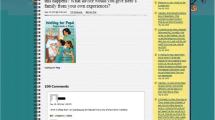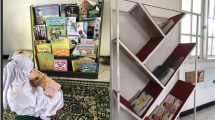Abstract
The purpose of this study was to examine how the social practices of African American families—with children in grades K-2—changed as a result of participating in a family literacy program utilizing African American children’s literature. The families were exposed, through a series of workshops, to an abundance of children’s literature written by and about African Americans. Data sources included pre and post interviews conducted with parents, parental reading logs, and a reflective journal kept by the researcher. Findings suggested that parents increased the amount of time reading aloud to their children, passed along the information that they learned about African American children’s literature to family, friends, and co-workers, and began seeking out and developing an appreciation for quality African American children’s literature. This study was unique in that it involved collaboration between a public university, a local church, an African American sorority, and an innovative teacher recruitment initiative designed to increase the number of Black, male elementary school teachers.
Similar content being viewed by others
References
Anderson, R.C., Hiebert, E., Scott, J.A., and Wilkinson, I.A. (1985). Becoming a Nation of Readers: The Report of the Commission of Reading. Washington, DC: The National Institute of Education.
Bannerman, H. (1899). The Story of Little Black Sambo. New York: Platt & Munk.
Bell, Y., and Clark, T. (1998). Culturally Relevant Reading Material as Related to Comprehension and Recall in African-American Children. Journal of Black Psychology, 24(4), 455–475.
Berg, B. (2001). Qualitative Research Methods for the Social Sciences. Needham Heights, MA: Allyn & Bacon.
Billingsley, A., and Caldwell, C.H. (1991). The Church, the Family, and the School in the African American Community. The Journal of Negro Education, 60(3), 427–440.
Bishop, R.S. (1990). Mirrors, Windows, and Sliding Glass Doors. Perspectives, 6(3), ix–xi.
Bishop, R.S. (2007). Free within Ourselves: The Development of African American Children’s Literature. Portsmouth, NH: Heinemann.
Brooks, W.M., and McNair, J.C. (2009). “But This Story of Mine Is Not Unique”: A Review of Research on African American Children’s Literature. Review of Educational Research, 79(1), 125–162.
Clark, M. (1976). Young Fluent Readers: What Can They Teach Us?. Exeter, NH: Heinemann.
Clifton, L. (1976). Everett Anderson’s 1–2-3. New York: Holt, Rinehart & Winston.
Comer, J.P., and Poussaint, A.F. (1992). Raising Black Children. New York: Plume.
Crews, D. (1991). Bigmama’s. New York: Greenwillow.
Cullinan, B. (Ed.). (1987). Children’s Literature in the Reading Program. Newark, DE: International Reading Association.
Duke, N.K. (2000). 3.6 Minutes per Day: The Scarcity of Informational Texts in First Grade. Reading Research Quarterly, 35(2), 202–224.
Durkin, D. (1966). Children Who Read Early. New York: Teachers College Press.
Durkin, D. (1984). Poor Black Children Who Are Successful Readers: An Investigation. Urban Education, 19(1), 53–76.
Dyson, A.H., and Genishi, C. (2005). On the Case: Approaches to Language and Literacy Research. New York: Teachers College Press.
Edwards, P. (1992). Involving Parents in Building Reading Instruction for African-American Children. Theory into Practice, 31(4), 350–359.
Frazier, E.F. (1963). The Negro Church in America. New York: Schocken.
Geisel, T. (1957). The Cat in the Hat. New York: Random House.
Geisel, T. (1960). Green Eggs and Ham. New York: Random House.
Greenfield, E. (1978). Honey, I Love. New York: HarperCollins.
Harris, V.J. (1990a). Benefits of Children’s Literature. Journal of Negro Education, 59(4), 538–539.
Harris, V.J. (1990b). Multicultural Curriculum: African American Children’s Literature. Young Children, 46(2), 37–44.
Henderson, D.L., and May, J.P. (2004). Exploring Culturally Diverse Literature for Children and Adolescents. Boston, MA: Allyn & Bacon.
Hill, R. (1971). The Strengths of Black Families. New York: Emerson Hall.
Huey, E.B. (1908). The Psychology and Pedagogy of Reading. New York: Macmillan.
Johnson, D. (1990). Telling Tales: The Pedagogy and Promise of African American Literature for Youth. Westport, CT: Greenwood Press.
Lee, S., and Lee, T.L. (2002). Please, Baby, Please. New York: Simon & Schuster.
Lincoln, C.E., and Mamiya, L.H. (1990). The Black Church in the African American Experience. Durham, NC: Duke University Press.
Martin, M.H. (2004). Brown Gold: Milestones of African American Children’s Picture Books, 1845–2002. New York: Routledge.
Mays, B.E., and Nicholson, J.W. (1969). The Negro’s Church. New York: Arno Press.
McGill-Franzen, A., Allington, R., Yokoi, L., and Brooks, G. (1999). Putting Books in the Classroom Seems Necessary but Not Sufficient. Journal of Educational Research, 93(2), 67–74.
McKissack, P.C. (1986). Flossie and the Fox. New York: Dial.
McMillon, G.T., and Edwards, P.A. (2000). Why Does Joshua “Hate” School… But Love Sunday School? Language Arts, 78(2), 111–120.
McNair, J.C. (2010). Classic African American Children’s Literature. The Reading Teacher, 64(2), 96–105.
Middleton, J.A. (2001). A Role for the African American Church in Urban School Reform. Urban Education, 36(3), 426–437.
Morrow, L.M., Tracey, D.H., and Maxwell, C.M. (Eds.). (1995). A Survey of Family Literacy in the United States. Newark, DE: International Reading Association.
Nelson, K. (2005). He’s Got the Whole World in His Hands. New York: Dial.
Neuman, S. (1999). Books Make a Difference: A Study of Access to Literacy. Reading Research Quarterly, 34(3), 286–311.
Nolen, J. (2005). Hewitt Anderson’s Great Big Life. New York: Simon & Schuster.
Parker, M.H. (1990). Alpha Kappa Alpha Through the Years: 1908–1988. Chicago: Mobium Press.
Phillips, C.M. (2005). Sisterly Bonds: African American Sororities Rising to Overcome Obstacles. In T.L. Brown, G.S. Parks and C.M. Phillips (Eds.), African American Fraternities and Sororities: The Legacy and the Vision (pp. 341–359). Lexington, KY: University Press of Kentucky.
Pinkney, B. (1997). The Adventures of Sparrowboy. New York: Simon & Schuster.
Pinnell, G.S. (2001). What Does It Mean to Comprehend a Text? In G.S. Pinnell and P.L. Scharer (Eds.), Extending our Reach: Teaching for Comprehension in Reading, Grades K-2 (pp. 3–14). Columbus, OH: The Ohio State University.
Quiroa, R. (2001). The Use and Role of Multiethnic Children’s Literature in Family Literacy Programs: Realities and Possibilities. The New Advocate, 14(1), 43–52.
Resnick, M.B. (1987). Mothers Reading to Children. Reading Teacher, 40(9), 888–895.
Smith, S. (2002). “Would I Use This Book?” White, Female Education Students Examine Their Beliefs About Teaching. The New Advocate, 15(1), 57–66.
Steptoe, J. (Ed.). (1997). In Daddy’s Arms I Am Tall. New York: Lee & Low.
Teale, W. (1981). Parents Reading to Their Children: What We Know and Need to Know. Language Arts, 58(8), 902–912.
Teale, W. (1984). Reading to Young Children: Its Significance for Literacy Development. In H. Goelman, A. Oberg and F. Smith (Eds.), Awakening to Literacy (pp. 110–121). Portsmouth, NH: Heinemann.
Titscher, S., Meyer, M., Wodak, R., and Vetter, E. (2000). Methods of Text and Discourse Analysis. Thousand Oaks, CA: Sage Publications.
Van Ausdale, D., and Feagin, J.R. (2001). The First R: How Children Learn Race and Racism. Lanham, MD: Rowman & Littlefield.
Ward, J.V. (2000). The Skin We’re in. New York: Fireside.
Wells, G. (1985). Meaning Makers: Children Learning Language and Using Language to Learn. Portsmouth, NH: Heinemann.
Wollman-Bonilla, J. (1998). Outrageous Viewpoints: Teachers’ Criteria for Rejecting Works of Children’s Literature. Language Arts, 75(4), 287–295.
Woodson, J. (2002). Visiting Day. New York: Scholastic.
Acknowledgments
This study was funded by a Grant-in-Aid Award sponsored by the Research Foundation of the National Council of Teachers of English.
Author information
Authors and Affiliations
Corresponding author
Additional information
Jonda C. McNair is an Associate Professor of Literacy Education at Clemson University in South Carolina. She specializes in literature intended for youth with an emphasis on books written by and about African Americans and is currently serving as President of the Coretta Scott King Book Awards Committee.
Rights and permissions
About this article
Cite this article
McNair, J.C. “I Never Knew There Were So Many Books About Us” Parents and Children Reading and Responding to African American Children’s Literature Together. Child Lit Educ 44, 191–207 (2013). https://doi.org/10.1007/s10583-012-9191-2
Published:
Issue Date:
DOI: https://doi.org/10.1007/s10583-012-9191-2




